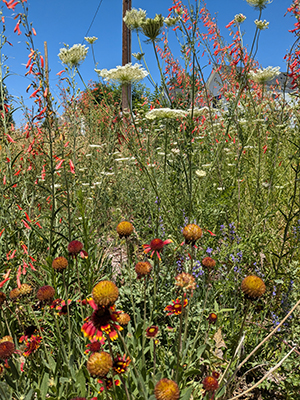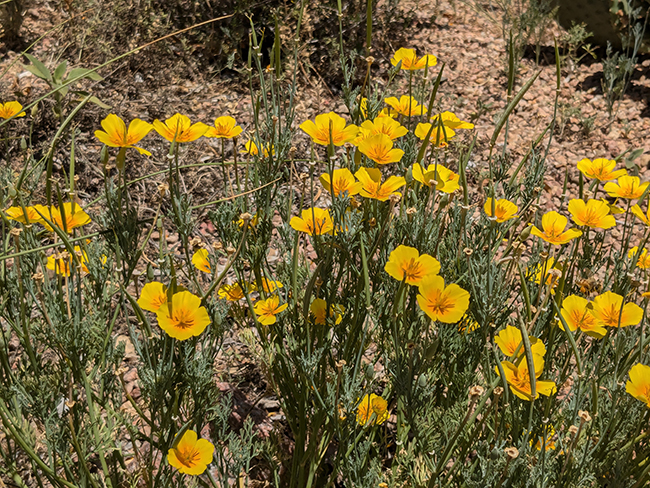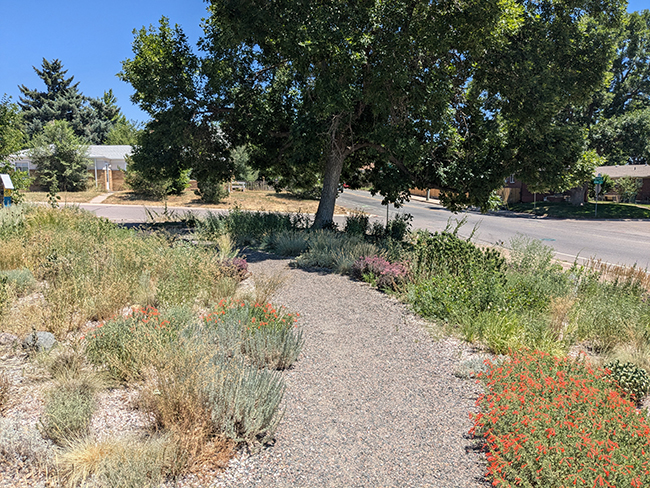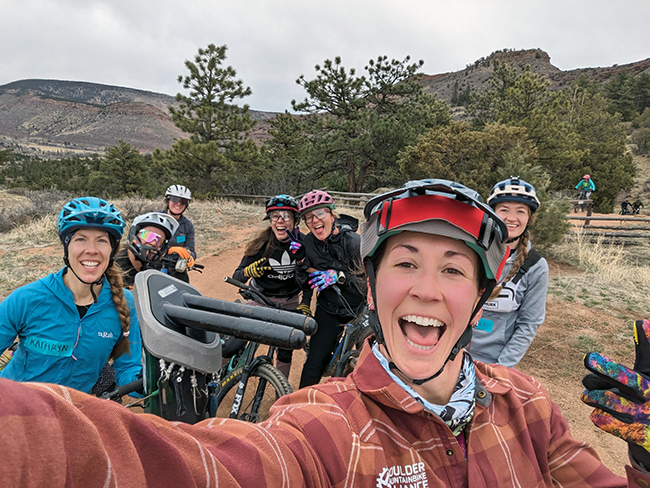Gardening that Gives Back
04 Aug 2024
The value of native plants in Colorado
Story and photos by Holly Bowers

The mercury is rising toward 90 degrees as a line begins to snake around the block at EarthLinks Colorado. More than 700 people have shown up for the fourth annual Denver Pollinator/Native Plant Swap, put on by Wild Ones Front Range in partnership with EarthLinks, the People & Pollinators Action Committee and the Colorado Native Plant Society. They wait in line for an hour for the chance to pick up plantings of trumpeted wild four o’clock, sturdy blue anise hyssop and more.
Why are people this excited about a native plant swap?
The last several years have seen an explosion of people recognizing the benefits of native plants, says Deborah Lebow-Aal, vice president of Wild Ones Front Range (WOFR), which helps Front Range residents plant, propagate and promote Colorado native plant species.
Mikl Brawner, co-owner and founder of Harlequin’s Gardens in Boulder, agrees. “When I first started the nursery and we would bring in 50 native shrubs, I’d still have 10 at the end of the year,” he says. “Now we can sell 50 native shrubs in a weekend because people have come to us.”
Native plant species are adapted to grow in our climate, soil and water levels. They reduce the need for water, fertilization and pesticides. According to WOFR, more than 55% of urban water use goes to landscaping, much of that to non-native, water-intensive Kentucky Bluegrass. After WOFR replanted Depot Park in Englewood with all native species, the city reduced water use there by 73% and eliminated the need for weekly mowing.

Native species also attract native pollinators, providing the food and shelter they need. Many of us are familiar with the example of monarch butterflies needing milkweed for their larvae to feed on. Monarchs are not unique in this regard—many pollinators need specific native plants for food. Those native plants support the rest of the ecosystem, too, and help increase climate resilience. Colorado native species tend to have deep roots, for example, which hold water during heavy rains and help prevent floods.
Plant swaps like the one put on by WOFR in June serve an important role in making native plant species more accessible. Many nurseries carry few, if any, native plant species because they’re seen as less “showy” than the cultivars that you typically see in garden stores.
Harlequin’s Gardens is an exception. After seeing the effects of drought in India and as an arborist in Colorado, Brawner grew interested in plants that need less water to survive. Eventually, he started his own garden on a dry plot of land off Rt. 36 in North Boulder, where Harlequin’s Gardens still stands today.
Brawner’s early experiments were not exactly successful. “I started killing plants right and left!” he says. But he took classes on xeriscaping and joined the North American Rock Garden Society and the Native Plant Society, where he learned more about drought-resistant Colorado plants. He put everything he learned into his garden, eventually growing it into a native plant nursery that serves gardeners in Boulder, Denver and the surrounding areas.
Home gardeners aren’t the only ones singing the praises of Colorado native plants, either. Boulder’s Open Space & Mountain Parks (OSMP) uses plant species native to Boulder County in restoration projects and landscaping around trailheads and buildings. OSMP considers several factors when choosing plants, including soil type, elevation, light, landscape position and the neighboring native plant communities.

Lynn Reidel, OSMP grassland plant ecologist, and Megan Bowes, OSMP restoration plant ecologist, explain that their teams try to choose species that will come in at different times as a restoration area matures—some species will fill in right away to provide cover, while others will come in over the course of years. OSMP also tries to include both “cool season” and “warm season” plants so that restoration areas have native plants throughout the growing season. That mimics naturally growing plant communities and provides protection from encroaching non-native species.
Reidel is frank about the threat that non-native species pose to Colorado native plants, even if those non-natives are drought resistant. “There are still a lot of non-native, ‘xeric’ garden plants that are sold and used in our area,” she explains. “Some of those behave and don’t spread from private land onto public land, but there is a very challenging legacy of introduced, non-native garden species that have escaped onto local public lands in natural areas, causing local open space programs to spend large amounts of money and time on non-native species management.”
So how can you turn your yard into a native plant garden full of Colorado species that will actively benefit our Front Range ecosystem?
WOFR refers to that practice as “Coloradoscaping,” and offers a free toolkit on their website. As a general best practice, it’s important to start by assessing your site and your soil. Consider the amount of shade and sun that your site gets, any hills or other landscape features, altitude and where you’ll irrigate. All of these factors will influence what plants you should choose. Assessing your soil is equally important. You want to choose plants that match your soil, so they’re set up to thrive.
Lebow-Aal also recommends looking around for inspiration. “Find a garden near you that has native plants so you can see what looks good together, or take a hike and see what grows well together,” she says. Native plant gardens can really look any way you want, whether that’s a prairie garden or a more formal, even English cottage-style, garden. Harlequin’s Gardens offers free tours of its display gardens throughout the year, and WOFR has planted demonstration gardens at Ekar Farm and at the intersection of E 16th Ave and Clarkson Street in Denver.
Seeing native plants in their natural habitat can be a great source of inspiration, too. “Boulder is really fortunate to have a lot of public open space with many examples of forest and grassland native plant communities that haven’t been altered by tilling or other big disturbances,” Riedel says. “Really any of our trails that get away from the sharp urban interface are good places to observe native plants and how they grow together.” She recommends going on guided hikes and attending workshops with groups such as OSMP, WOFR, the Colorado Native Plant Society and the Butterfly Pavilion.
One place that’s not great to see native plants? Chautauqua. Chautauqua Meadow is one of several places in the front country that have only small pockets of native species left. Thanks to historical agricultural use and “ornamental escapees” from nearby yards, these areas are instead dominated by non-native species. As you’re selecting plants, choose Colorado native species, not just drought-resistant (sometimes called xeriscape) species.
It’s also good to start small when you’re starting your native plant garden. “Take a piece of your landscape and play with it,” Lebow-Aal recommends. Learn from Brawner’s example—your ideas may not work out, and you may kill some plants as you start out. Limiting the scope of your initial experiments will keep the project from getting overwhelming, and you won’t invest too much time or money in an idea that doesn’t pan out.
From there, continue to learn, gather inspiration and try new things. As WOFR says, “There’s no such thing as a completed landscape.” And know that your efforts matter. “Every native plant, even one, will make a difference,” Lebow-Aal says.












